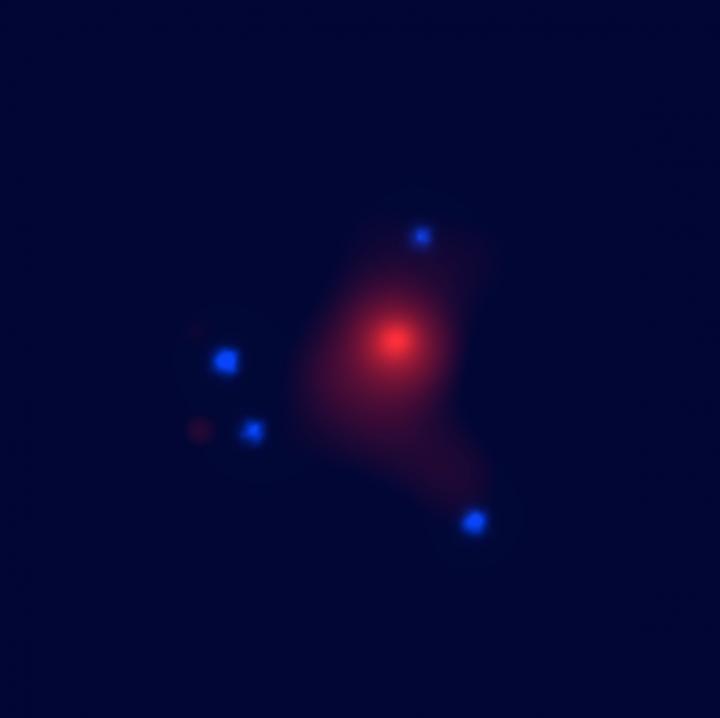14.12.2019

X-ray image of the gravitational lens system SDSS J1004+4112 taken by the Chandra X-ray Observatory. The central red extended emission is from the hot gas in the foreground lens galaxy cluster at z=0.68 and the four blue point sources are the lensed images of the background quasar at z=1.734. The planet mass objects are detected in the foreground galaxy cluster, which has an age about half of the universe (Credit: Univ. of Oklahoma).
NORMAN, OKLA. - A University of Oklahoma research group is reporting the detection of extragalactic planet-mass objects in a second and third galaxy beyond the Milky Way after the first detection in 2018. With the existing observational resources, it is impossible to directly detect planet-mass objects beyond the Milky Way and to measure its rogue planetary population.
Members of the group include Xinyu Dai, associate professor in the Homer L. Dodge Department of Physics and Astronomy, OU College of Arts and Sciences, with Ph.D. student Saloni Bhatiani and former postdoctoral researcher Eduardo Guerras.
"The detection of planet-mass objects, either free-floating planets or primordial black holes, are extremely valuable for modeling of star/planet formation or early universe," said Dai. "Even without decomposing the two populations, our limit on the primordial black hole population are already a few orders of magnitude below previous limits in this mass range."
The research group has identified a novel technique that uses quasar microlensing to probe the planet population within distant extragalactic systems. They have been able to constrain the fraction of these planet-mass objects with respect to the galactic halo by studying their microlensing signatures in the spectrum of the lensed images of distant bright Active Galactic Nuclei.
The group surmised these unbound objects to be either free-floating planets or primordial black holes. Free-floating planets were ejected or scattered during stellar/planetary formation. Primordial black holes are formed in the early phase of the universe due to quantum fluctuation. The results are of significant as they confirm that planet-mass objects are indeed universal in galaxies. Moreover, the first-ever constraints at the planet-mass range within the intracluster region of a galaxy cluster are presented here.
The constraints on the primordial mass black holes in the planet mass range are a few orders of magnitude below previous limits.
"We are very excited about the detections in two news systems," said Bhatiani. "We can consistently extract signals from planet mass objects in distant galaxies. This opens a new window in astrophysics."
The observational data used for this work comes from decade-long observations conducted by NASA's Chandra X-ray observatory. The observational evidence for these planet-mass objects was derived from the microlensing signals that appear as shifts in the X-ray emission line of the quasar. These observational measurements were matched against microlensing simulations that were computed at the OU Supercomputing Center for Education and Research.
Comparison of the research group's models with the observed microlensing rates allowed them to constrain the fraction of these planet-mass objects in the two extragalactic systems about 0.01% of the total mass. This work is a follow-up of the previous research work done by Dai and Guerras that provided the first indirect evidence for the existence of free-floating planets outside the Milky Way.
The two systems are Q J0158?4325 and SDSS J1004+4112. To be able to confirm the existence of planet-mass objects in a galaxy cluster when the universe was half of its current age is quite extraordinary. The group's analysis confirms the existence of these planet-scale objects ranging from Jupiter to Moon mass at extragalactic distances and provides the most stringent constraints at this mass range. These results are in agreement with the current constraints for the unbound planet-mass objects within the Milky Way Galaxy. The results are published in November 2019 issue of the Astrophysical Journal (DOI: 10.3847/1538-4357/ab46ac).
Quelle: AAAS
